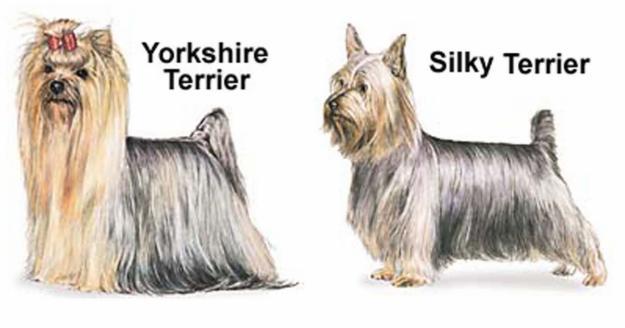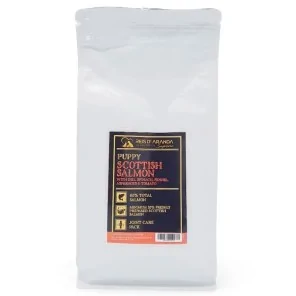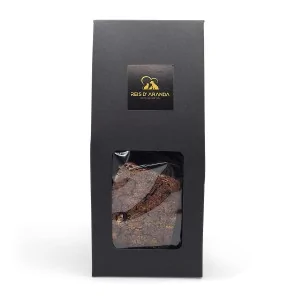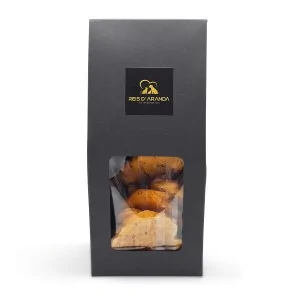Its name says it all: the Vienna blue rabbit comes from Austria. Not only is it beautiful with its shiny blue-grey...
THE SILKY TERRIER
INTRODUCTION
The Australian Silky Terrier is a small terrier-type breed of dog. The breed was developed in Australia, although the ancestors of the dogs were from Britain. It is closely related to the Australian terrier and Yorkshire terrier. In North America the breed is simply called the Silky Terrier, while in its country of origin - as well as in the rest of the world - it is called the Australian Silky Terrier.
THE ORIGIN OF THE SILKY TERRIER
The history of the Silky Terrier goes back to 19th century Australia, where it developed as a distinctive breed with unique characteristics. Its origin lies in a mixture of different terriers, including the Australian Terrier, the Yorkshire Terrier and other rough-haired terriers imported from Britain.
At that time in Australia, terriers were bred to assist in pest control on poultry farms, especially to hunt mice and rats. Among these terriers was a type known as the ‘rough-haired terrier’ or ‘broken-haired terrier’. This small, brave, rat-hunting dog had a rough, textured coat of blue and tan or sand-coloured fur.
As time progressed, Australian breeders began to differentiate between different types of terriers based on their coat and other characteristics. In 1898, the Kennel Club of New South Wales offered separate classes for ‘Australian Rough Coated Terriers’ and ‘Silky Coated Terriers’. This distinction marked the beginning of the process of establishing the Silky Terrier's own identity.
In effect, the Silky resembles the Yorkshire Terrier as well as the Australian Terrier, but is neither. Those characteristics that distinguish it from a Yorkie and an Aussie are often the very qualities that breeders and owners of Silkys find most charming. They are small but not fragile, energetic but not barky.
At that time, many Silky breeders also bred Australian Terriers and/or Yorkshire Terriers, and there was considerable interbreeding between them. As the breed developed, an early standard for the Silky Terrier was established in 1903. This standard focused on its silky, straight, glossy coat, as well as other desirable physical and temperament characteristics.
In the late 1950s, the Silky Terrier began to appear in dog shows in the United States, which helped to increase its visibility and popularity. However, it was initially met with some confusion and derision. Many people mistook it for a larger Yorkshire Terrier because of its similar appearance. Over time, Silky breeders and owners worked to educate people about the differences between the two breeds and to highlight the unique qualities of the Silky.
Over the years, the Silky Terrier has won admirers for its elegant appearance and lively temperament. Its silky coat and compact size make it an attractive dog both as a household companion and in the show ring. Although a small breed, the Silky Terrier is energetic, intelligent and courageous.
Today, the Silky Terrier has managed to maintain its status as a distinct and unique breed. While the Silky Terrier's popularity may vary in different parts of the world, the breed continues to be appreciated for its playful and loyal personality. It is an ideal dog for active families and for those looking for a small-sized but energetic companion.
THE SILKY TERRIER STANDARD
GENERAL APPEARANCE: Compact, moderately low set, moderately long, with a refined build but with sufficient substance to suggest the ability to hunt and kill domestic rodents. The silky, smooth coat, parted in the middle to form a parting, gives a neat appearance.
BEHAVIOUR / TEMPERAMENT: Should exhibit Terrier characteristics, showing keen alertness, activity and vigour.
HEAD: The head is of moderate length, slightly shorter from the tip of the nose to the region between the eyes than from the same position to the occiput. The head should be strong, with Terrier characteristics, being moderately broad between the ears.
CRANIAL REGION
SKULL : Flat and without roundness between the eyes, with a fine, silky tuft of hair which does not cover the eyes (a long fall of hair on the front face or cheeks is objectionable).
FACIAL REGION
TRUFFLE: Must be black in colour.
HAIR: Close fitting and thin.
JAWS / TEETH: Jaws strong, teeth even and not crowded; the upper incisors closely overlapping the lower incisors (scissor bite).
EYES : Small, oval, never round or prominent; their colour should be as dark as possible with an expression of keen intelligence.
EARS: Small, V-shaped, fine pinna, set high on the skull, carried erect and completely free from long hair.
NECK: Of medium length, refined and slightly arched, set gracefully into the shoulders. Well covered with long silky hair.
BODY : Should be moderately long in proportion to the height of the dog.
TOPLINE : Level at all times (both standing and moving). It is a serious fault if the topline is out of line or convex.
LOIN : Should be strong.
CHEST: Moderate depth and width.
SIDE: Well arched, extended back to a strong loin.
TAIL: Preferably docked, set on high and carried erect, but not too high. Should not be feathered. Without docking, the first three vertebrae should be carried erect or slightly curved, but never curved over the topline. Should not be curled. Its length, giving an appearance of overall balance. In accordance with the description of the docked tail, the undocked tail should also be free of feathering.
LIMBS:
FOREQUARTERS: The bones are finely defined and rounded, straight and well laid under the body, showing no weakness in the metacarpals.
Shoulders: Thin and well laid back, well adapted with well angulated arms and very close to the ribs.
ELBOWS: Neither turned in nor out.
HINDQUARTERS:
THIGHS: Well developed.
KNEES: Well angulated.
HIPS: Well angulated, seen from behind, well let down and parallel to each other.
FEET: Cat feet, small, with good pads; toes close together; nails should be black or very dark.
GAIT / MOVEMENT: Should be free, straight, showing no slackness in shoulders or elbows, no turning in or out of feet and pasterns. The hindquarters should give a thrust with ample flexibility in the knees and hocks. Seen from behind, the movement should be neither too narrow nor too wide.
COAT
HAIR: Smooth, fine and glossy, of silky texture. The length of the coat should not be such as to impede the dog's movement and should allow light to be seen under the dog. The front and hind feet should be free from long hair.
COLOUR : All shades of blue and tan are acceptable, the more intense the colour and the more clearly defined the better. Silver and white are not acceptable.
On the tail the colour should be blue to very dark. It is desirable that the tuft on the head be blue or fawn in colour.
The distribution of blue and tan should be as follows: tan around the base of the ears, muzzle and on the sides of the cheeks; blue from the base of the skull to the tip of the tail, on the forelegs to near the carpal joint and on the hind legs near the hock joint; a tan line is shown below the knees and from the carpal and tibio-tarsal joints to the toes and around the anus. The blue colour of the body must be free from tan. Tan markings must be free from tarnish. Black is permitted in puppies, but blue must be established by 18 months of age.
SIZE AND WEIGHT
HEIGHT AT WITHERS:
- MALES: 23 to 26 cm. Height at withers
- FEMALES: May be slightly shorter.
WEIGHT: Weight in proportion to size.
FAULTS: Any departure from the foregoing points should be considered a fault and the seriousness with which the fault should be regarded should be in exact proportion to its degree.
Any dog showing clear signs of physical or behavioural abnormalities should be disqualified.
NOTE: Male dogs should have two apparently normal appearing testicles, fully descended into the scrotum.
WHAT IS THE DIFFERENCE BETWEEN THE SILKY TERRIER AND THE YORKSHIRE TERRIER?

When viewed side by side the differences are clear:
The first thing is the size and the weight since the Yorkshire Terrier is a more square and compact dog that the Silky Terrier, the Yorkshire Terrier has a maximum weight of 3,200kg whereas the Silky Terrier can reach the 8, the muzzle of the Yorkshire is smaller, shorter and rounder and its coat much longer and abundant (especially in the zone of the head).
It is very easy to find crosses of Yorkshire and Silky in the pet shops or fruit of crosses between individuals who do not know the differences between them, as well as deceptions in which Silkys are sold or yielded by Yorkshires due to this reason (the ignorance of the population in general).
CARE OF THE SILKY TERRIER
The Silky Terrier is a dog of simple cares, they require a brushing a week and monthly baths (unlike the Yorkshire Terrier that requires more meticulous cares and more frequent baths when they are kept with long hair), they do not require oiling or packing of the hair and due to their high levels of energy they require to make daily exercise. Their hunting instincts are not as pronounced as in the Australian Terrier.
In terms of food they need omega 3 to keep their skin and coat in good condition, so fish based feeds are a good option as well as Angus beef (due to its sodium content, excellent for heart care), the Reis d'Aranda brand has both varieties.
In general it is a very healthy breed and as it is ‘not very commercial’ (it is not fashionable) its diseases are few and easy to control by means of the appropriate health tests:
- Patellar luxation: Patellar luxation is one of the most common orthopaedic diseases in dogs and is diagnosed in 7% of puppies. The disease mainly affects small dogs, especially breeds such as boston and yorkshire terriers, chihuahuas, pomeranians and miniature poodles. The incidence in larger breeds has been increasing over the last ten years and breeds such as Chinese shar pei, smooth retriever, akita and Pyrenean mountain dog are now considered to be predisposed to the disease. Patellar luxation affects both knees in half of the cases, potentially leading to discomfort and loss of function. Patellar dislocation is occasionally caused by traumatic injury to the knee, resulting in sudden, severe limb lameness.
- CATARACTS: Cataracts in dogs are a loss of transparency of the lens that helps them to see better, i.e. loss of the crystalline lens. Due to the breakage of the crystalline tissue, the eyes become cloudy and cause blurred vision. It is essential to treat them as soon as possible because the more time passes, the more dense they become and the more likely it is that the canines will have a total loss of vision without the ability to recover it. There are several causes of cataract disease in dogs. One of them may be by nature or by the dog's old age, as we have already mentioned above, due to the rupture of the crystalline lens. But there are also other causes of cataracts in dogs, such as trauma, injury, inflammation of the eye or diabetes. However, the most common cause or the one most commonly diagnosed is hereditary cataracts. Age is not a determining factor in this cause as they can appear when the animal is young.
- GLAUCOMA: Glaucoma is a group of diseases that cause progressive damage to the optic nerve, with the consequent reduction of the visual field. This disease can be primary or secondary, and does not cause symptoms until it is very advanced, so if it is not diagnosed in time it can cause blindness.
- Distichiasis: Distichiasis is an abnormality in which extra eyelashes grow from the hair follicles of the eyelids, but in an abnormal position, i.e. inwards instead of outwards. These extra eyelashes are usually thicker and stiffer than normal eyelashes, which can cause irritation, scratching of the ocular surface and other eye problems (not to be confused with entropion).
CONCLUSION
The Silky Terrier is a little known breed that is very easy to confuse with the Yorkshire Terrier in spite of the substantial differences between both canine breeds, its ease of care and cheerful and active personality make it a good pet for families with big children, as long as they give it the education and socialisation that terriers need so much to avoid typical behavioural problems.
Leave a comment
Log in to post comments
















